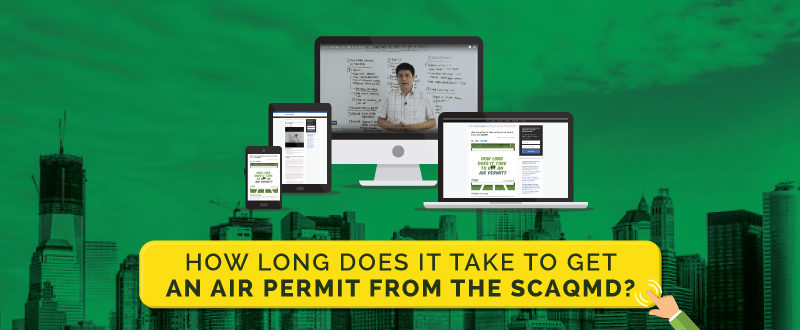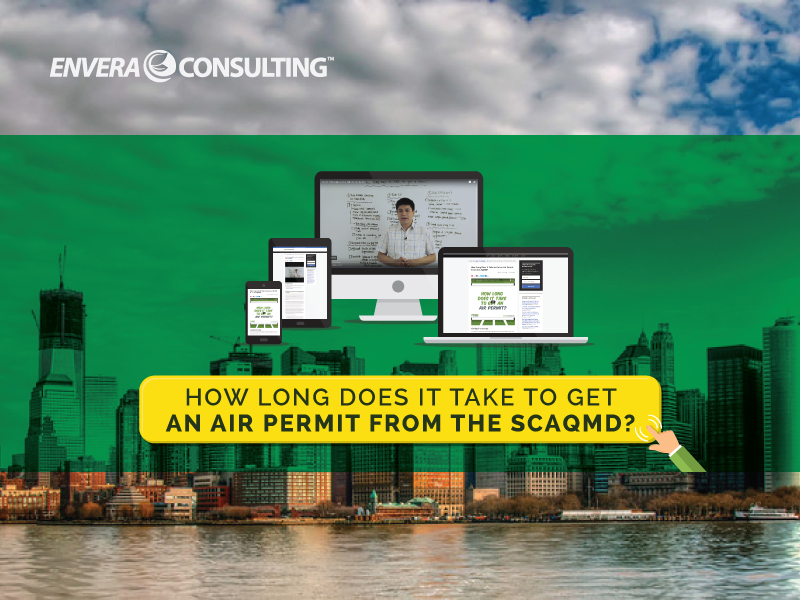

See bottom of post for video on this subject.
When it comes to how long you’ll have to wait to get your SCAQMD permit, the most accurate answer is:
It depends.
Processing timelines for air permits depend on a number of factors, including:
- Whether the air permit must undergo a public notice
- Whether the air permit must be reviewed by the Environmental Protection Agency (EPA)
- Whether the project must satisfy any requirements under the California Environmental Quality Act (CEQA)
- Whether the permit contains all necessary components for processing
Despite these factors, there are two points you can rely on:
- There are statutory permit-processing timelines set forth by the South Coast Air Quality Management District (SCAQMD).
- There are ways of accelerating the permitting process.
Let’s explore both of these items in this article.
Responsibilities in Preparing and Processing Air Permits
Believe it or not, both you and the SCAQMD have specific responsibilities and obligations when it comes to submitting and the processing of air permit applications.
Responsibilities as an applicant (Rule 210)
As part of SCAQMD Rule 210, you as the applicant must file air permit applications in the form prescribed by the SCAQMD.
And while it is not easy to find, you can find the standard format for a Certified Permitting Professional (CPP)-style permit application on the SCAQMD’s website.
The secret to preparing complete air permit applications is this:
You must include all of the information necessary to allow the SCAQMD to determine if the proposed equipment can operate in compliance with all of the applicable rules and regulations.
To understand how this works, you will need to familiarize yourself with all of the rules and regulations of the SCAQMD. And more specifically, the specific rules that apply to the piece of equipment that you are permitting.
The key here is that you must include all of the information necessary to allow the SCAQMD to process your application.
Responsibilities of the SCAQMD as a Processing Agency (Rule 212)
On the other hand, under SCAQMD Rule 212, the agency must determine if the permitted equipment is designed, controlled, or equipped with air pollution control equipment in order to operate without emitting air contaminants in violation of the SCAQMD’s rules or the California Health and Safety Code.
The SCAQMD can only make that determination if you provide them with all of the information needed to complete their assessment. So make sure your application is complete!
Permit Processing Timelines
As we talked about earlier, the permit processing timelines vary on various factors, but there are required — and specific — permit processing timelines in the SCAQMD’s rules and regulations that specify how long they have to process a permit application.
Let’s look at three rules that cover these timelines.
Timelines under SCAQMD Rule 210
SCAQMD Rule 210 specifies that the permit engineer has 30 days upon receipt of the application to determine if it is complete (i.e., contains all of the required information). If the application is incomplete, the permit engineer will notify you of the deficiencies, after which you must supply the missing information.
Upon receipt of the missing information, the permit engineer has an additional thirty days to review the application and determine whether or not it is complete.
If the application is still not complete, any additional reviews allow the permit engineer 120 days to either deny or accept the application depending on if it is complete or not. Such a delay could severely impact your project, so make sure your application is complete! (I know I sound like a broken record, but I feel I need to reiterate this point so it really hits home.)
Timelines under SCAQMD Rule 1710
In certain cases, permits will be filed to the SCAQMD as part of the EPA’s Prevention of Significant Deterioration program (PSD). Under the PSD, covered facilities are required to demonstrate that the emissions from their project will not cause or contribute to a violation of “any national ambient air quality standard in any air quality control region.”
Generally speaking, larger and more complex projects are subject to the permitting requirements of the PSD program. As a result, the permit processing timelines are different.
For example, SCAQMD Rule 1710 allows the SCAQMD to issue a preliminary decision on the PSD permit application 180 days after receipt of the application. Rule 1710 also allows the SCAQMD to issue the final permit within 180 days of receiving the complete permit application.
Timelines under SCAQMD Rule 3003
SCAQMD Rule 3003 outlines the permit processing timelines for Title V facilities.
- For applications for initial permits, significant permit revisions, and permit renewals, the SCAQMD has 18 months after receipt of a complete application to issue the permit.
- For applications submitted for an administrative permit revision, the SCAQMD has 60 days after receipt of a complete application to issue the permit.
- For applications submitted for minor permit revisions, the SCAQMD typically has 90 days after receipt of the complete application to issue the permit.
- For applications submitted for de minimis significant permit revisions, the SCAQMD has typically 180 days after the receipt of a complete application to issue the final permit.
What Impacts the Permit Processing Timelines?
Again, there are many factors — too many to list here — that can affect the processing timeline of a permit application, but these three are among the most common:
1. Insufficient information
By far, the most common reason the processing time can be affected is insufficient information. (You knew I was going to say that, didn’t you?)
As mentioned in the SCAQMD’s June 2014 Stationary Source meeting, Mohsen Nazemi indicated that permit engineers spend ~20% of their time trying to obtain additional information from permit applicants. That equates to more than eight hours per week trying to get information from a specific applicant (assuming a 40-hour week). So make an engineer happy. Submit a complete application.
2. Finalization of CEQA documents
Under CEQA, state and local agencies within California must analyze and publicly disclose environmental impacts related to a proposed project. These agencies are also required to adopt all feasible measures to mitigate those disclosed impacts.
For these projects, the project owner makes these disclosures in the form a written document, often referred to as a “CEQA document.” The process to prepare, circulate, and finalize a CEQA document is another process in and of itself (which is not being discussed in this article).
Most of the permit applications submitted to the SCAQMD are exempt from CEQA. However, for the few that are not, the process to finalize an entire CEQA document can take anywhere between six to twelve months.
3. The public notice process
In certain cases, the SCAQMD is required to notify all addresses within a given area of the project of their intent to issue a specific permit. Such public notification, as the process is called, occurs when the project is located in close proximity to a school or has emissions that pose a significant health risk to the public due to the air toxics from the project.
Once a public notification is made, there is a 30-day period to submit public comments related to the project.
The Key Takeaway
The single most important thing you can do to accelerate the processing of your air permit is to prepare a permit application according to the Certified Permitting Professional (CPP) standard. This includes:
- Submitting correct and completed forms
- Submitting correct fees
- Submitting a detailed engineering evaluation
- Responding promptly to information requests
Permit engineers can only process your permit application as quickly as they receive the information that is needed to do so.
With that being said, if your application does not have all of the information in it, or the engineer has questions on the process or the equipment being permitted, it is in your best interest to respond to them as quickly as possible. If you don’t, the SCAQMD can deny your permit application.
At the end of the day, the SCAQMD wants to issue your permit just as much as you want it to be issued.